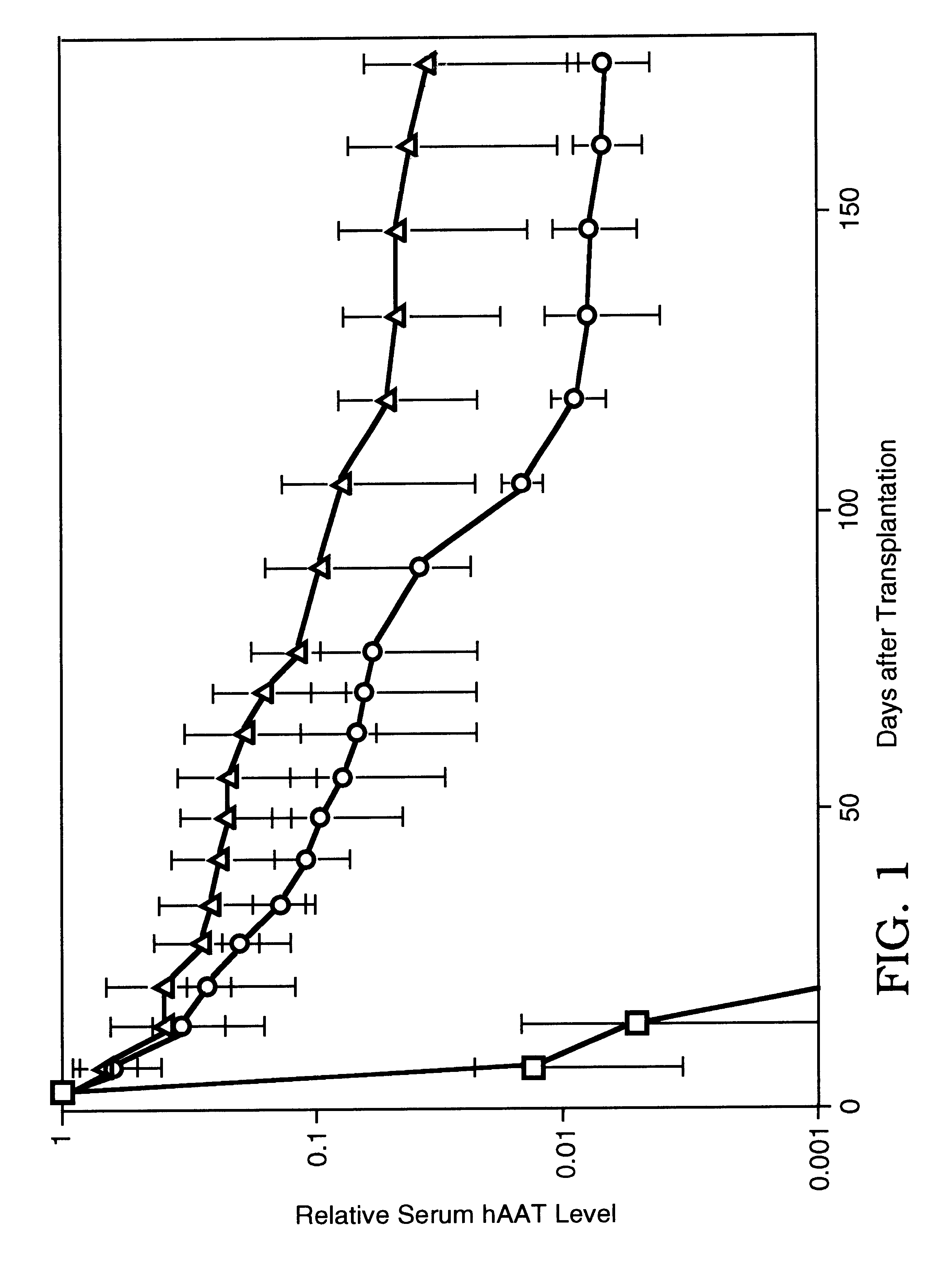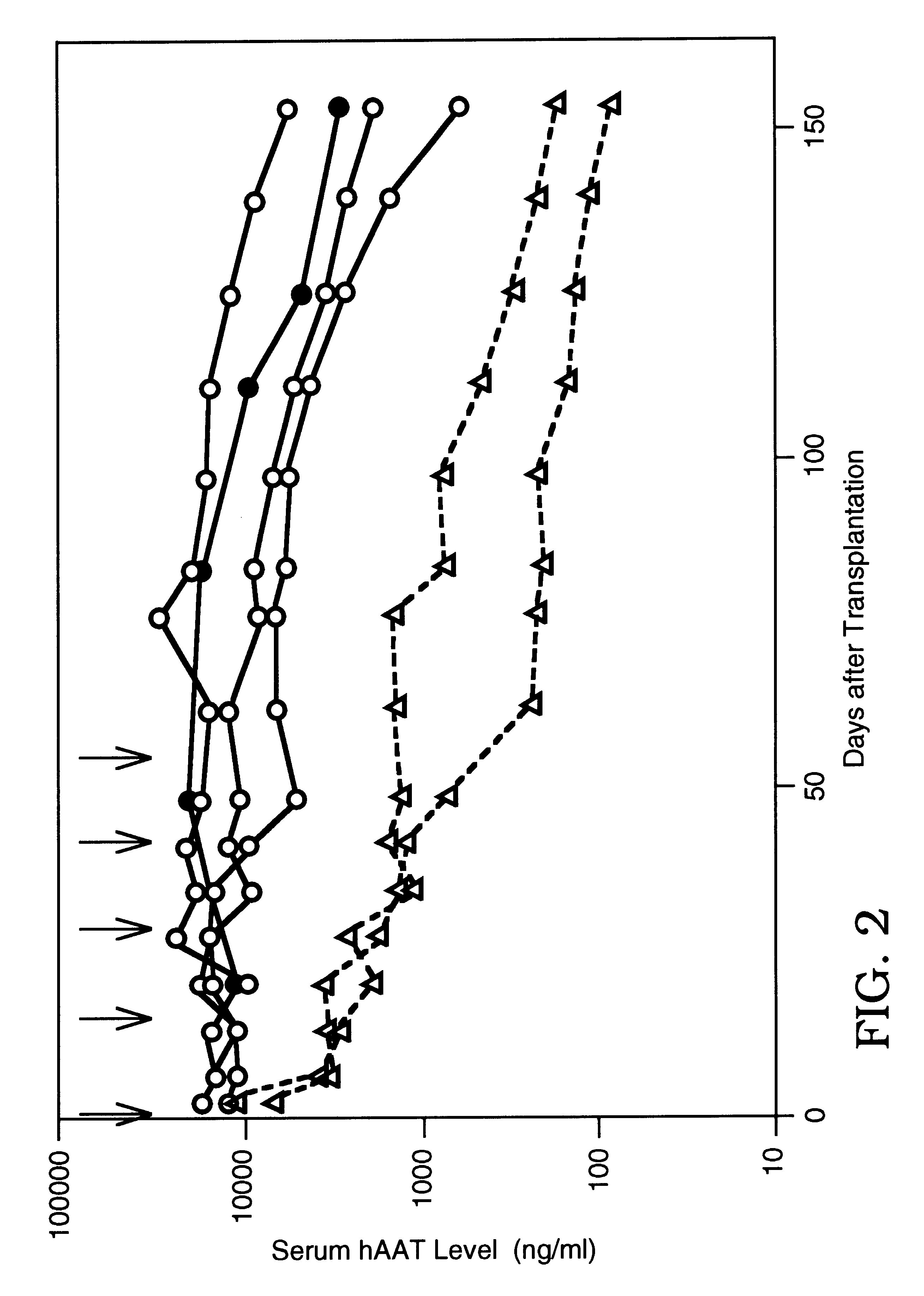Animals comprising human hepatocellular tissue.
a technology of hepatocytes and animals, applied in the field of animals comprising human hepatocytes, can solve the problems of animal hepatocytes being also susceptible to infection, and achieve the effect of improving human hepatocyte biology studies
- Summary
- Abstract
- Description
- Claims
- Application Information
AI Technical Summary
Benefits of technology
Problems solved by technology
Method used
Image
Examples
example 1
The first studies were geared at finding a suitable location to maintain the human hepatocytes in the host animal. The region under the kidney capsule, portal vein and subcutaneous space on the dorsal surface of NOD / scid mice were tested as potential sites for human hepatocyte transplantation (FIG. 1). Previous studies have shown that different strains of mice were tested for their ability to maintain hepatoyctes after intraportal, subcutaneous, or intra-renal capsule transplantation. The greatest persistence were observed in NOD / scid mice, and these mice were subsequently used in the present studies, although other mice (including NIH3) can be used with the described methods.
Human hepatocytes were isolated from various donors (all HBV, HCV and HIV negative) by routine collagenase perfusion and low-speed centrifugation. The hepatocytes used for transplantation under the kidney capsule or in the subcutaneous space were mixed with MATRIGEL.TM. (Becton-Dickinson) prior to transplantati...
example 2
Experiments to determine the cause of the loss of human hepatocyte function were then undertaken. One testable theory is that the loss was due at least in part to the absence of an essential factor such as human hepatocyte growth factor (HGF). Because HGF has a half-life on the order of minutes, an agonistic anti-human c-Met murine IgG1 antibody was used in combination with the transplantation procedure. Fifty micrograms of the c-Met antibody was administered every 2 weeks for the first 57 days levels of hepatocyte stabilization of hAAT expression with or without c-Met were determined, as shown in FIGS. 2 and 3. FIGS. 2 and 3 represent two separate experiments with the same parameters.
All the mice were transplanted with human hepatocytes and MATRIGEL.TM. at day 0, and a subset of mice received c-Met at days 1, 15, 29, 43, 57; controls did not receive c-Met. The absolute concentrations of hAAT between the two experiments result from the variability in the quality of liver tissue at t...
example 3
In order to establish whether or not the transplanted hepatocytes could serve as an in vivo model for infection with human hepatitis viruses, three animals that received human hepatocytes in the kidney capsule were infused 3 days later with 0.25 to 1.4.times.10e.sup.8 HBV DNA equivalents by injection into the transplant and intravenously. Serum samples were periodically monitored for HBsAg and HBV DNA titers (FIGS. 4 and 5, respectively).
Mice were transplanted with human hepatocytes at day-3 and c-Met antibody was administered at day-2 and then on the same schedule as the experiment of Example 2. Control animals received no hepatocytes. Mice were either inoculated with 250 .mu.l of HBV infected single human serum containing 2.5.times.10.sup.7 HBV DNA equivalents or 250 .mu.l of pooled donor sera containing 1.4.times.10.sup.8 HBV DNA equivalents in a split dose administered via the kidney capsule and intravenously. The later two mice were transplanted with hepatocytes that were cultu...
PUM
| Property | Measurement | Unit |
|---|---|---|
| temperature | aaaaa | aaaaa |
| time | aaaaa | aaaaa |
| time | aaaaa | aaaaa |
Abstract
Description
Claims
Application Information
 Login to View More
Login to View More - R&D
- Intellectual Property
- Life Sciences
- Materials
- Tech Scout
- Unparalleled Data Quality
- Higher Quality Content
- 60% Fewer Hallucinations
Browse by: Latest US Patents, China's latest patents, Technical Efficacy Thesaurus, Application Domain, Technology Topic, Popular Technical Reports.
© 2025 PatSnap. All rights reserved.Legal|Privacy policy|Modern Slavery Act Transparency Statement|Sitemap|About US| Contact US: help@patsnap.com



